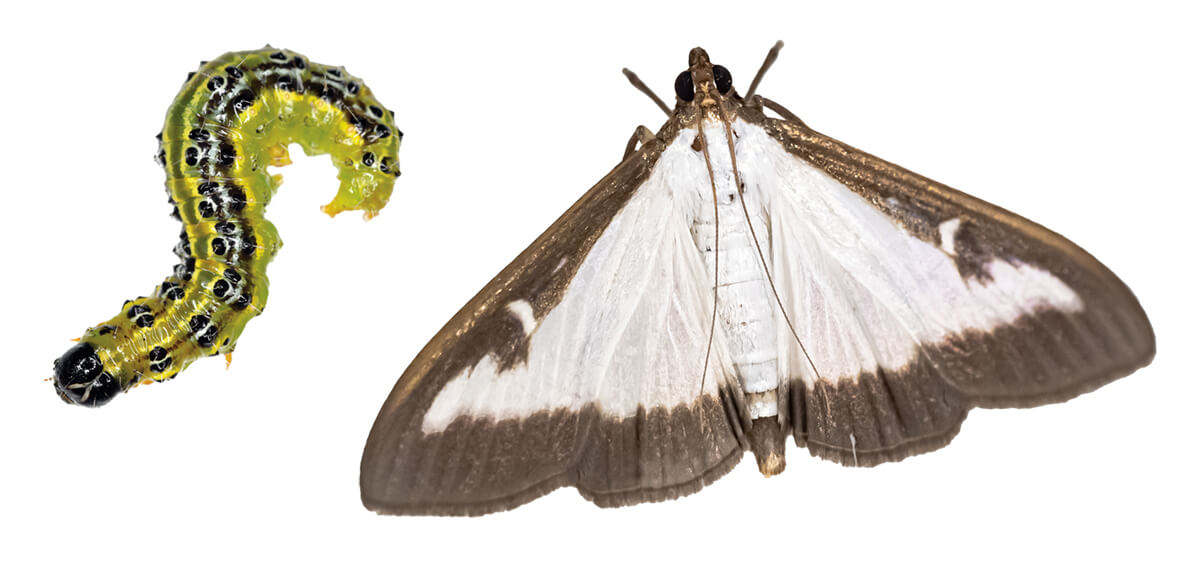June 7, 2024

Spotted lanternfly poses a serious economic threat to Ontario's wine, horticulture and forestry industries.
Be on the lookout for invasive pests this season
Landscape and horticulture professionals are reminded to routinely monitor trees and shrubs for two invasive pests that pose a major threat to Ontario landscapes: spotted lantern fly (SLF) and box tree moth (BTM).

In mid-May, small black-headed green larvae emerge from white webbed hibernarium and feed voraciously on boxwood leaves. The caterpillar later develops a black stripe along its body and leaves behind webbing and frass deposits (excrement).
After about two weeks of feeding, the pest spins a cocoon to pupate and soon after, develops into an adult moth that has white wings with brown margins. The adult lives about 14 days and can fly between seven to 10 km where it will lay tiny, flat yellow eggs on the underside of leaves.
Larvae are the damaging life stage of this pest and have three main periods of activity: May to mid-June, July to mid-August and September.
Caterpillars can be controlled using an application of Bascillus thuringiensis (commercially called Dipel 2X DF), which is registered for use in Canada and is safe for people and pets. Other products with the active ingredient Bascillus thuringiensis subspecies kurstaki can be found and purchased at local garden centres for domestic use. Plants should be inspected after five to seven days to see if a second application is required.
Clippings from infested plants can be placed in a securely closed black plastic garbage bag and left in direct sunlight for 48 hours in order to effectively kill the caterpillar larvae.
Ontario is part of the regulated area for box tree moth, therefore if you find BTM in Ontario, you do not need to report it. On May 14, 2024, the CFIA updated the regulated area for all boxwood plants to include Ontario and all provinces to the east with the exception of Prince Edward Island. Boxwood plants for planting can move freely within and between the related provinces.
Signs you have box tree moth
Landscape Ontario has many resources online to help industry professionals in the fight against box tree moth, including a downloadable pest identification card, life cycle infographic, images of infested boxwood, safe disposal practices and more. Simply visit LandscapeOntario.com/box-tree-moth.
Spotted lanternfly
Last year, live and dead spotted lanternfly (Lycorma delicatula) adults were positively identified by Canadian Food Inspection Agency (CFIA) in Ontario and Quebec. This 2.5 cm long pest with grey spotted wings and bright red hind wings already has a history of causing major damage in the northeastern United States and is literally on our doorstep.
Spotted lanternfly can lay egg masses on any hard surfaces and can be found on trees, stones, outdoor furniture, firewood, trailers, and boats to name a few. SLF feed on over 70 tree species, but are particularly drawn to wild and cultivated grapes, and the invasive Tree of Heaven (Ailanthus altissima). Other common hosts include black walnut, maple, oak, poplar, willow, and vines like hops. With the pest detected across the border in New York State, it poses a huge threat to Canada’s grape (wine) industry in the Niagara Region and is anticipated to pose a significant regulatory burden to the nursery and landscape sector.
Spotted lanternfly has one generation per year. Egg masses can be found from September to May. From approximately May to July, SLF appears as a nymph that is mostly black with white spots. The final nymphal instar, which can be found from July to August, remains black with white spots but develops distinct red patches. Adults are the most recognizable life stage with their grey spotted wings and red hind wings and can be found as early as July and until a hard frost in the late fall. The adults congregate in large swarms to feed on the trunks and branches of preferred host trees, leading to a heavy buildup of ‘honeydew’ which promotes the growth of unsightly black fungal mats called sooty mould.
Any sightings of SLF should be reported immediately to CFIA using the link gfl.me/hbJH.
Spotted lanternfly can lay egg masses on any hard surfaces and can be found on trees, stones, outdoor furniture, firewood, trailers, and boats to name a few. SLF feed on over 70 tree species, but are particularly drawn to wild and cultivated grapes, and the invasive Tree of Heaven (Ailanthus altissima). Other common hosts include black walnut, maple, oak, poplar, willow, and vines like hops. With the pest detected across the border in New York State, it poses a huge threat to Canada’s grape (wine) industry in the Niagara Region and is anticipated to pose a significant regulatory burden to the nursery and landscape sector.
Spotted lanternfly has one generation per year. Egg masses can be found from September to May. From approximately May to July, SLF appears as a nymph that is mostly black with white spots. The final nymphal instar, which can be found from July to August, remains black with white spots but develops distinct red patches. Adults are the most recognizable life stage with their grey spotted wings and red hind wings and can be found as early as July and until a hard frost in the late fall. The adults congregate in large swarms to feed on the trunks and branches of preferred host trees, leading to a heavy buildup of ‘honeydew’ which promotes the growth of unsightly black fungal mats called sooty mould.
Any sightings of SLF should be reported immediately to CFIA using the link gfl.me/hbJH.

Box tree moth
Box tree moth (Cydalima perspectalis) was first detected in Toronto in 2018 and has recently spread across the province and throughout Eastern Canada. Box tree moth can be found in most urban areas of Ontario now; early detection of box tree moth and intervention is critical to ensure boxwood plants remain healthy and overcome feeding damage.In mid-May, small black-headed green larvae emerge from white webbed hibernarium and feed voraciously on boxwood leaves. The caterpillar later develops a black stripe along its body and leaves behind webbing and frass deposits (excrement).
After about two weeks of feeding, the pest spins a cocoon to pupate and soon after, develops into an adult moth that has white wings with brown margins. The adult lives about 14 days and can fly between seven to 10 km where it will lay tiny, flat yellow eggs on the underside of leaves.
Larvae are the damaging life stage of this pest and have three main periods of activity: May to mid-June, July to mid-August and September.
Caterpillars can be controlled using an application of Bascillus thuringiensis (commercially called Dipel 2X DF), which is registered for use in Canada and is safe for people and pets. Other products with the active ingredient Bascillus thuringiensis subspecies kurstaki can be found and purchased at local garden centres for domestic use. Plants should be inspected after five to seven days to see if a second application is required.
Clippings from infested plants can be placed in a securely closed black plastic garbage bag and left in direct sunlight for 48 hours in order to effectively kill the caterpillar larvae.
Ontario is part of the regulated area for box tree moth, therefore if you find BTM in Ontario, you do not need to report it. On May 14, 2024, the CFIA updated the regulated area for all boxwood plants to include Ontario and all provinces to the east with the exception of Prince Edward Island. Boxwood plants for planting can move freely within and between the related provinces.
Signs you have box tree moth
- Skeletonization: Box tree moth caterpillars feed voraciously on boxwood leaves, leaving behind skeletonized foliage.
- Defoliation: Severe infestations lead to defoliation, weakening the plants and making them susceptible to other stressors.
- Silken webbing: Similar in appearance to spider nests, box tree moth larvae spin a fine web around a couple of boxwood leaves in the fall, creating a small protected ‘house’ for the larva to overwinter. These can be difficult to find but are usually located deeper within the foliage.
- Life stages present: If you see larvae (green caterpillars with a black head) or adult moths (white wings with light brown margins), it is clear you have box tree moth. Adult moths are nocturnal and are not often found within the boxwood foliage, so the life stages you’re more likely to observe are larvae, and in some cases, pupae.
Landscape Ontario has many resources online to help industry professionals in the fight against box tree moth, including a downloadable pest identification card, life cycle infographic, images of infested boxwood, safe disposal practices and more. Simply visit LandscapeOntario.com/box-tree-moth.
